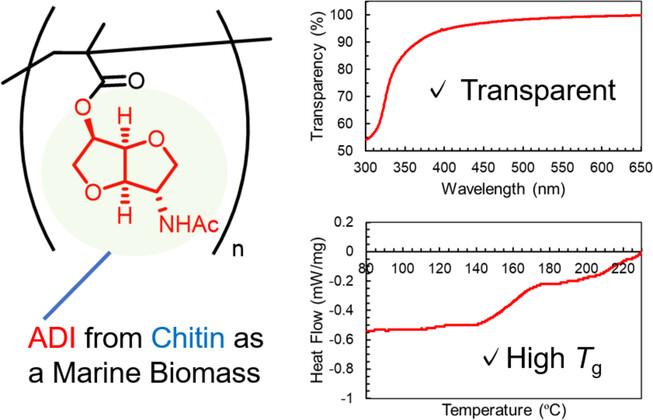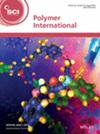Yasuhito Koyama, Takuya Sagawa, Kazufumi Kohno, Kento Sato, Hirokazu Kobayashi, Atsushi Fukuoka
求助PDF
{"title":"以几丁质衍生的2-乙酰胺-2-脱氧异山梨酯为重复单元的生物质基聚甲基丙烯酸酯的合成与性能","authors":"Yasuhito Koyama, Takuya Sagawa, Kazufumi Kohno, Kento Sato, Hirokazu Kobayashi, Atsushi Fukuoka","doi":"10.1002/pi.6701","DOIUrl":null,"url":null,"abstract":"<p>Synthesis and applications of biobased polymers have been extensively studied in order to reduce the use of petroleum-based polymers and likewise environmental load. Several biobased polymers have been produced on a commercial large scale to date. However, the lineup of biobased high-performance polymers with transparency and high glass transition temperature is inadequate and their development is a critical issue. In this article, we design a new biobased polymethacrylate comprising rigid <i>cis</i>-fused bicyclic 2-acetamide-2-deoxyisosorbide (ADI) as a repeat unit. We have recently invented catalytic transformation systems from chitin as a marine biomass to ADI as a new nitrogen-containing platform chemical. The ADI-based polymethacrylate is synthesized via free radical polymerization of the methacrylic acid ester of ADI initiated by (NH<sub>4</sub>)<sub>2</sub>S<sub>2</sub>O<sub>8</sub> and <i>N</i>,<i>N</i>,<i>N</i>′,<i>N</i>′-tetramethylethylenediamine in dimethylsulfoxide–H<sub>2</sub>O mixed solvent. The molecular weight and its dispersity are estimated by size exclusion chromatography on the basis of polymethylmethacrylate standards. UV–visible spectroscopy demonstrates the high transparency of the polymer in the visible wavelength region. Differential scanning calorimetry analysis of the polymer clarifies the remarkably high glass transition temperature, compared with that of polymethylmethacrylate. The thermal decomposition temperature of the polymer is also evaluated by thermogravimetric analysis. On the basis of the favorable properties of the ADI-based polymer, the present study proposes it as a nitrogen-containing biobased polymer useful for real-world applications. © 2024 Society of Chemical Industry.</p>","PeriodicalId":20404,"journal":{"name":"Polymer International","volume":"74 10","pages":"898-904"},"PeriodicalIF":3.6000,"publicationDate":"2024-09-24","publicationTypes":"Journal Article","fieldsOfStudy":null,"isOpenAccess":false,"openAccessPdf":"","citationCount":"0","resultStr":"{\"title\":\"Synthesis and properties of biomass-based polymethacrylate comprising chitin-derived 2-acetamide-2-deoxyisosorbide as a repeat unit\",\"authors\":\"Yasuhito Koyama, Takuya Sagawa, Kazufumi Kohno, Kento Sato, Hirokazu Kobayashi, Atsushi Fukuoka\",\"doi\":\"10.1002/pi.6701\",\"DOIUrl\":null,\"url\":null,\"abstract\":\"<p>Synthesis and applications of biobased polymers have been extensively studied in order to reduce the use of petroleum-based polymers and likewise environmental load. Several biobased polymers have been produced on a commercial large scale to date. However, the lineup of biobased high-performance polymers with transparency and high glass transition temperature is inadequate and their development is a critical issue. In this article, we design a new biobased polymethacrylate comprising rigid <i>cis</i>-fused bicyclic 2-acetamide-2-deoxyisosorbide (ADI) as a repeat unit. We have recently invented catalytic transformation systems from chitin as a marine biomass to ADI as a new nitrogen-containing platform chemical. The ADI-based polymethacrylate is synthesized via free radical polymerization of the methacrylic acid ester of ADI initiated by (NH<sub>4</sub>)<sub>2</sub>S<sub>2</sub>O<sub>8</sub> and <i>N</i>,<i>N</i>,<i>N</i>′,<i>N</i>′-tetramethylethylenediamine in dimethylsulfoxide–H<sub>2</sub>O mixed solvent. The molecular weight and its dispersity are estimated by size exclusion chromatography on the basis of polymethylmethacrylate standards. UV–visible spectroscopy demonstrates the high transparency of the polymer in the visible wavelength region. Differential scanning calorimetry analysis of the polymer clarifies the remarkably high glass transition temperature, compared with that of polymethylmethacrylate. The thermal decomposition temperature of the polymer is also evaluated by thermogravimetric analysis. On the basis of the favorable properties of the ADI-based polymer, the present study proposes it as a nitrogen-containing biobased polymer useful for real-world applications. © 2024 Society of Chemical Industry.</p>\",\"PeriodicalId\":20404,\"journal\":{\"name\":\"Polymer International\",\"volume\":\"74 10\",\"pages\":\"898-904\"},\"PeriodicalIF\":3.6000,\"publicationDate\":\"2024-09-24\",\"publicationTypes\":\"Journal Article\",\"fieldsOfStudy\":null,\"isOpenAccess\":false,\"openAccessPdf\":\"\",\"citationCount\":\"0\",\"resultStr\":null,\"platform\":\"Semanticscholar\",\"paperid\":null,\"PeriodicalName\":\"Polymer International\",\"FirstCategoryId\":\"92\",\"ListUrlMain\":\"https://scijournals.onlinelibrary.wiley.com/doi/10.1002/pi.6701\",\"RegionNum\":4,\"RegionCategory\":\"化学\",\"ArticlePicture\":[],\"TitleCN\":null,\"AbstractTextCN\":null,\"PMCID\":null,\"EPubDate\":\"\",\"PubModel\":\"\",\"JCR\":\"Q2\",\"JCRName\":\"POLYMER SCIENCE\",\"Score\":null,\"Total\":0}","platform":"Semanticscholar","paperid":null,"PeriodicalName":"Polymer International","FirstCategoryId":"92","ListUrlMain":"https://scijournals.onlinelibrary.wiley.com/doi/10.1002/pi.6701","RegionNum":4,"RegionCategory":"化学","ArticlePicture":[],"TitleCN":null,"AbstractTextCN":null,"PMCID":null,"EPubDate":"","PubModel":"","JCR":"Q2","JCRName":"POLYMER SCIENCE","Score":null,"Total":0}
引用次数: 0
引用
批量引用




 求助内容:
求助内容: 应助结果提醒方式:
应助结果提醒方式:


